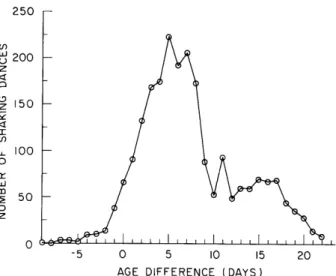XIV.
COMMUNICATIONS BIOPHYSICS
A. Animal Communication
Academic and Research Staff Prof. H. Steven Colburn Prof. Lawrence Frishkopf Nathaniel Durlach
1. THE SHAKING DANCE OF HONEYBEE WORKERS: EVIDENCE FOR AGE DISCRIMINATION
National Institutes of Health (Grant 5 PO1 GM14940-07) Robert A. Gahl
One of the dances of the honeybee Apis mellifera L. is called the shaking dance. The shaking dance is enacted by a worker bee (called the "shaker") that vibrates its body dorsoventrally by means of rapid contractions of the leg muscles. The shaker usually makes contact with another bee that remains motionless during the shake and then resumes its previous activity. Workers perform this dance on all three castes of bees,2 but we studied shaker bees only in the worker caste. A bee, after shaking once, will typically crawl across a portion of the comb and soon shake again, either alone, on another bee, or on several bees together. A sequence of such events is termed a "shaking run. " Occasionally actions of trophallaxis or waggle dances are performed during a shaking run.
Methods
A small observation hive (4. 6 x 16 X 16 cm) was constructed to provide enough room for approximately 500 bees. A hybrid queen and several of her workers were placed in the hive on June 25, 1972. Every day 10-30 newly emerged workers from a stock obser-vation hive were color-marked to enable individual identification,3 and added to the small colony. In all, 820 bees were marked, but because of attrition the population peaked between 200 and 350. This miniature colony was maintained for observation until
July 26, 1972.
Observations were made of shaking dances performed by these bees, whose color-marking allowed for quick and accurate determination of age. The colony was observed at random times during the day. The data included the type of shaking situation (i. e., shaking alone, one-on-one, or one-on-several), the age of the shaker, and if another bee was involved, the age of the bee shaken. Also, if trophallaxis occurred during a shaking run, the ages of the participants were recorded, and whether the shaker was the receiver or the provider of food was noted.
250 w 200 Z z 150 I () L 100 O cr LUi m 5 50 z -5 0 5 10 15 20
AGE DIFFERENCE (DAYS)
Fig. XIV- 1. Number of one-on-one shaking dances as a function of the age difference (age of shaker minus age of bee shaken) of the bees involved. n (number of shaking dances) = 2237.
350 300 250 200 0 5 10 15 20 25 AGE (DAYS)
Fig. XIV-2 Number of
of shaker
n = 2237.
one-on-one shaking dances as a function of age (solid line) and of bee shaken (dashed line).
(XIV. COMMUNICATIONS BIOPHYSICS)
